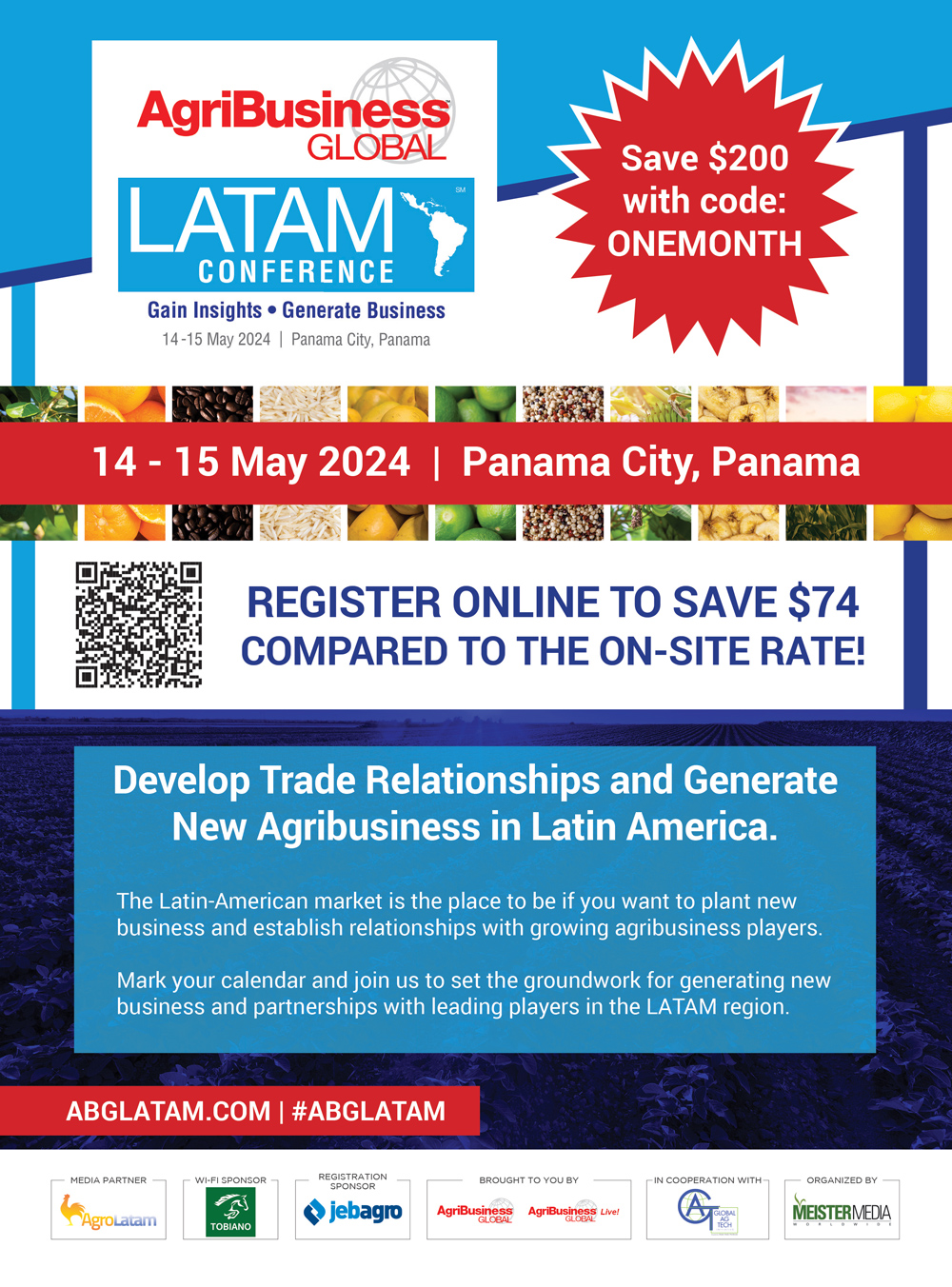Mexico’s Black Market Cycle
Scroll Down to Read
By Renee Targos
Editor
As Mexico ramps up its fruit and vegetable production, exporting food to the U.S. and other countries, it shows potential for industry growth in crop protection, both agrochemicals and biologicals, as well as plant health. However, a major deterrent sets the country back from this growth. Black market activity ranges high in comparison to other countries and makes legitimate business difficult.

Javier Fernandez, Legal Counsel and Director of Regulatory Affairs, CropLife Latin
Javier Fernandez, Legal Counsel and Director of Regulatory Affairs, CropLife Latin America says, “A Mexican NGO concerned with the issue carried out a study to reveal that issue in amounted US$1.4 billion or 20% of the market. That 20% consisted of 8% product without registration, a whopping 25% of smuggled, 8% counterfeit or adulterated, and 11% stolen.”
Illicit agrochemicals are defined as counterfeits of banned or registered products, imported or exported illegally, stolen, or unregistered products for crop use.
The Transnational Alliance to Combat Illicit Trade (TRACIT)’s Tackling the Sale of Illicit Pesticides on E-Commerce Platforms report illustrates that Mexico isn’t the only country dealing with the misuse of highly regulated chemicals. The report states that the “share of illegal pesticides on the global market ranges from 10% to as much as 25%” with annual revenues of US$8 billion to US$20 billion.
Mexico’s 20% puts them in the higher range of illicit activity, alongside of Kenya (20% of market) and India which is “25% by value and 30% by volume” as reported by the Indian Chambers of Commerce and Industries [FICCI]. Another LATAM country, Brazil, is also a target of illegal agrochemical imports. “Brazil could surpass the billion-dollar mark in illegal pesticide trade,” says Fernandez. “The Instituto de Desenvolvimento Economico e Social de Fronteiras (IDESF) has estimated the market loss is 25%.”
Good intentions could fuel the issue. While the Food and Agriculture Organization of the United Nations strives to rid the use of highly hazardous products (HHPs) through banning, this creates a gap for growers who need effective treatments to ensure crop yields.
“Unfortunately, activists who make a living out of fomenting pesticides bans manipulate the HHP definition to lobby for their cause,” says Fernandez. “If a regulator falls for banning a pesticide without leaving a cost-effective substitute behind, granting enough time to exhaust inventories while informing sufficiently farmers about the decision, the perfect conditions for illegal trade are given. Bad guys are not dumb. On the contrary, they do carry out thorough market intelligence and capture these market openings opportunistically.”
Last year, Mexico had two bills in Congress introducing the removal of HHPs, with glyphosate as a target, an agrochemical that in 2023 the European Commission decided to approve for continued use for the next 10 years.

Piyatida Pukclai, Regional Sales & Regulatory Policy Manager (Asia-Pacific) for Knoell
“Mexico’s federal government initially planned to ban glyphosate by January 31, 2024, but due to the lack of substitutes, this has been postponed until March 31, 2024,” says Piyatida Pukclai, Regional Sales & Regulatory Policy Manager (Asia-Pacific) for Knoell. “As of April 1, 2024, authorizations and permits for glyphosate will cease.”
Growers Role in Illegal Imports
With gaps in the crop protection market brought on by bans and resistance issues, growers are searching for options that will work. The idea that growers might be looking for solutions is one theory, but also, there is the cost savings of black-market products.
“We had a considerable debate about the farmer’s role last year,” says Fernandez. “One has the romantic image of a small-plot farmer being fooled by wrongdoers. Sure, that happens. But if our member companies feel the pain in their bottom lines in hundreds of millions of dollars, the issue can’t be reduced to smaller growers using a sachet here and there. There must be an important number of farmers, of all sizes, who knowingly take the risk to use bogus products in their fields.”

Dr. Nicolas Potrie, Director of Tafirel
Dr. Nicolas Potrie, Director of Tafirel, says that growers often know what they are getting into when they purchase illegal agrochemicals. “The fake labels often look ridiculous with unusual colors and spelling of names. Anyone that is used to purchasing the legal product will immediately doubt its legitimacy. That is the main reason we can say that it is not a deception from the seller. Usually, the farmer that buys the illegal product knows very well the risk of this action.”
TRACIT’s e-commerce sales of illicit pesticides report outlines three top risks to growers:
- Health: unknown and unregulated formulations can have negative health effects on those applying the product as well as those exposed to it.
- Environmental: can destroy soil, contaminate water, and pollute air as well as affect the health of wildlife.
- Economic: make crops unfit for market due to residues, destroy crops and undermine legitimate crop protection products.
With these risks also comes the complications of making a business deal with unethical people.
“It is usually a one-shot business deal that normally ends in bad result for at least one of the participants,” says Potrie.
In some instances, growers are deceived and end up paying high prices for unregistered products. In an intelligence gathering investigation with the Ciudad de Este in Paraguay, Fernandez found that “because one of the red flags for counterfeits is a lower price, we found out criminals started charging a similar price to the original to cover up their act. So, not only are criminals deceiving the consumer, but they are also receiving a huge premium for their bogus products.”
Making Growth Difficult
As black-market agrochemicals take away business from legitimate companies who follow registration processes, it can stunt the industry in coming up with solutions that follow the course of sustainability.
“An industry dedicated to investing an estimated 15% of its turnover in R&D to bring state of the art plant science technology to famers is quite an effort,” says Fernandez. “Our members need to recoup their investment in R&D to continue innovating and support sustainable agriculture.”

Daniel Traverso, Vice President of Anasac International Corporation and Director of Anasac Colombia and Mexico, Ltd.
Daniel Traverso, Vice President of Anasac International Corporation and Director of Anasac Colombia and Mexico, Ltd., says that the black market is Mexico is a huge problem. “The problem is that the authorities do not invest the necessary resources to provide efficient control, so people deal with illegal products at low prices, so it is sometime not easy to compete there,” says Traverso.
Smuggling Product
Illegal products are brought into Mexico and other Latin American countries through neighboring countries or mislabeled as a biologicals to pass customs.
“By definition, criminal organizations operate in hiding,” says Fernandez. “They use falsified documentation, do not pay taxes, and stay in the shadows. Their modus operandi is quite creative and adapts to each market.”
In response to black market activity and OECD reports on gang activity in agriculture, CropLife Latin America created an e-learning tool to identify illegal pesticides.
Future Solutions
The answers to combat the black market are complicated and specific to each region and country that faces the problem. However, NGOs, governments and associations are combining resources to solve the problem.
“It is a concoction of legislation and agencies, and it differs from jurisdiction to jurisdiction,” says Fernandez. “We have mapped out the laws and agencies in certain countries, such as Brazil, Colombia, and Paraguay, to educate users about reporting options and foment cooperation between agencies such as police, customs, and regulators. Effectiveness is contingent on authority resources, intelligence, and other variables.”
Education is also a big component in driving better outcomes.
Potrie says, “The associations need to make more efforts to work together with the regulatory institutions to promote the legal products and to explain to the growers this importance.” •
